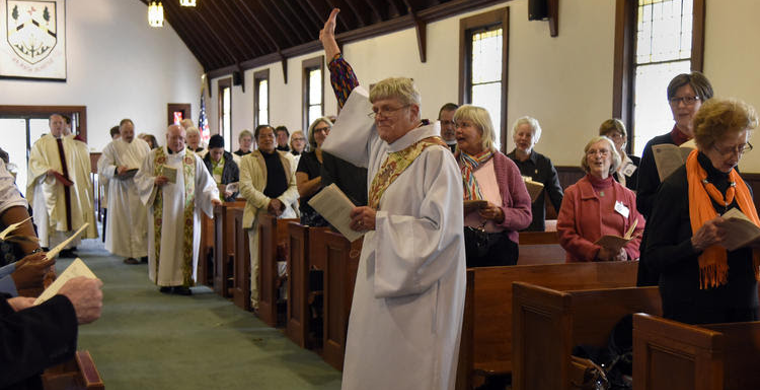North Baltimore Episcopal, Lutheran churches combine
Facing declining attendance, Baltimore churches of different denominations combine
By Carrie Wells
The Baltimore Sun
http://www.baltimoresun.com/
Nov. 1, 2015
As the Sunday service began, two leaders stepped forward with pitchers full of holy water from their two churches. As the congregation gave thanks for the gift of baptism, they poured the water into one vessel.
The unusual ceremony was meant to mark the joining of two North Baltimore churches, the Episcopal Church of the Nativity and the Lutheran Church of the Holy Comforter, that had faced declining congregations and financial struggles. The leaders of the two churches see their melding as crucial to their survival and ability to attract new congregants.
"People are saying that we're moving to a post-denominational time, that young people don't care if you're Baptist or Methodist or Presbyterian," said the Rev. T. Stewart Lucas, the rector of Nativity. "They just want good, authentic worship and service to those who are in need. So, in a way, we're going back to the basics of studying the Word, praying together and serving together, and I think there are lot of people who are hungry for that message."
Church membership has been on the decline nationwide for years, leaving church leaders responsible for paying for buildings too large for their slimmed-down congregations. About 59 percent of people polled by Gallup in 2013 said they were a member of a church or synagogue, down from 70 percent in 1992. And some may inflate the frequency of their attendance to pollsters. A study last year by the Public Religion Research Institute found 31 percent of people reported attending church weekly when responding online, versus 36 percent when responding by phone.
Lucas and the Rev. David Eisenhuth, the pastor of Holy Comforter, said they hope their joining together will inspire other churches facing the same challenges to consider a similar path.
Eisenhuth said two years ago, a member of his church's governing body took a hard look at the organization's finances and forced them to confront the reality that they were on shaky ground. The building, in the 5500 block of York Road, had been built in the 1950s for a peak congregation of 3,000. Yet weekly attendance was down to about 150 people, he said. Nativity was also facing declining attendance and financial challenges.
Eisenhuth said he began sending out "spies" to investigate nearby services to see if any would be a good match. Holy Comforter has a diverse congregation that is about a quarter Liberian, and Nativity's similarly diverse congregation impressed church leaders.
The Rev. Canon Dan Webster, a spokesman for the Episcopal Diocese of Maryland, said the two congregations experimented at first with having separate services, then after a few trial runs of combined services, liked the feeling of a fuller congregation. Their new slogan is "better together."
Lucas said jokingly that the hardest part has been combining the two church kitchens, as some members are proud of their roles there. Worship will be combined using elements of both faiths, and the church leaders said there are many similarities among how Lutheran and Episcopalian services are held, so the combination didn't seem like too much of a leap. Congregants and high-level church officials on both sides signed off on the change.
The two churches remain separate nonprofit institutions with separate finances. The Holy Comforter buildings are for sale, while worship will take place at Nativity, which is in the Cedarcroft neighborhood near Towson.
Lucas and Eisenhuth said the change has excited the congregation, which had felt stagnant. The challenges, such as deciding which furniture could be gotten rid of, seemed minor. But not everyone was on board with the change, and not all the Holy Comforter congregants are expected to make the switch.
"Some people simply just don't feel like they can make the change at this point in their lives, and that's sad, but the reality was the church was closing, so you stick together," Lucas said.
On Sunday, the church was nearly full, and a table full of homemade breads waited for the congregants to share on their way home.
Priscilla Vaughn, a 76-year-old member of Nativity, said the idea of combining the churches seemed "radical" when first proposed but eventually made sense. She said "there's not much difference" between the two faith's beliefs.
"I think it's a shame when a long-established place has to say, 'Well, it's time to move, time to regroup,'" she said. "I think we don't know how it's going to be, but it's going to be good."
Eisenhuth said other churches should consider joining forces, given today's challenges.
"It's really easy to ignore those things, most congregations just don't want to do that, and will just die and go away," Eisenhuth said. "My people wanted to continue as a congregation, even if that meant leaving the building and going somewhere else."














